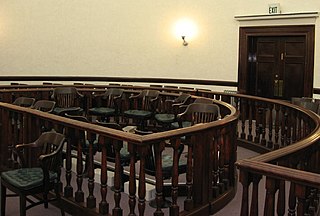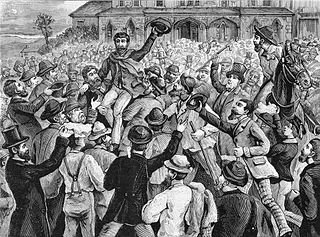Jury instructions, directions to the jury, or judge's charge are legal rules that jurors should follow when deciding a case. They are a type of jury control procedure to support a fair trial.

A jury trial, or trial by jury, is a lawful proceeding in which a jury makes a decision or findings of fact. It is distinguished from a bench trial in which a judge or panel of judges makes all decisions.

A jury is a sworn body of people convened to render an impartial verdict officially submitted to them by a court, or to set a penalty or judgment. Juries developed in England during the Middle Ages, and are a hallmark of the Anglo common law legal system. They are still commonly used today in Great Britain, the United States, Canada, Australia, and other countries whose legal systems are descended from England's legal traditions.
Jury nullification (US), jury equity (UK), or a perverse verdict (UK) generally occurs when members of a criminal trial jury believe that a defendant is guilty, but choose to acquit the defendant anyway, because the jurors consider that the law itself is unjust, that the prosecutor has misapplied the law in the defendant's case, or that the potential punishment for breaking the law is too harsh. Some juries have also refused to convict due to their own prejudices in favour of the defendant.

In common law jurisdictions, an acquittal certifies that the accused is free from the charge of an offense, as far as the criminal law is concerned. The finality of an acquittal is dependent on the jurisdiction. In some countries, such as the United States, an acquittal operates to bar the retrial of the accused for the same offense, even if new evidence surfaces that further implicates the accused. The effect of an acquittal on criminal proceedings is the same whether it results from a jury verdict or results from the operation of some other rule that discharges the accused. In other countries, the prosecuting authority may appeal an acquittal similar to how a defendant may appeal a conviction.
A hung jury, also called a deadlocked jury, is a judicial jury that cannot agree upon a verdict after extended deliberation and is unable to reach the required unanimity or supermajority. Hung jury usually results in the case being tried again.
A trier of fact, or finder of fact, is a person, or group of persons, who determines facts in a legal proceeding, usually a trial. To determine a fact is to decide, from the evidence, whether something existed or some event occurred. Various aspects of a case that are not in controversy may be the "facts of the case" and are determined by the agreement of the separate parties; the trier of fact need not decide such issues.
The Fully Informed Jury Association (FIJA) is a United States national jury education organization, incorporated in the state of Montana as a 501(c)(3) not-for-profit organization. FIJA works to educate all citizens on their authority when they serve as jurors. FIJA educates the public, provides commentary on current jury-related cases, and assists defendants with jury authority strategies — including the right to veto bad laws and the misapplication of laws by refusing to convict the defendant. The organization was formed in the summer of 1989 by Larry Dodge, a Montana businessman, and his friend Don Doig. They formed FIJA following discussions about forming such a group at the National Libertarian Party convention in Philadelphia in 1989.
Beyond a reasonable doubt is a legal standard of proof required to validate a criminal conviction in most adversarial legal systems. It is a higher standard of proof than the balance of probabilities and is usually therefore reserved for criminal matters where what is at stake is considered more serious and therefore deserving of a higher threshold.
Jury selection is the selection of the people who will serve on a jury during a jury trial. The group of potential jurors is first selected from among the community using a reasonably random method. Jury lists are compiled from voter registrations and driver license or ID renewals. From those lists, summonses are mailed. A panel of jurors is then assigned to a courtroom.
Scientific jury selection, often abbreviated SJS, is the use of social science techniques and expertise to choose favorable juries during a criminal or civil trial. Scientific jury selection is used during the jury selection phase of the trial, during which lawyers have the opportunity to question jurors. It almost always entails an expert's assistance in the attorney's use of peremptory challenges—the right to reject a certain number of potential jurors without stating a reason—during jury selection. The practice is currently confined to the American legal system.

Bigby v. Dretke 402 F.3d 551, the U.S. Court of Appeals for the Fifth Circuit heard a case appealed from the United States District Court for the Northern District of Texas on the issue of the instructions given to a jury in death penalty sentencing. The decision took into account the recent United States Supreme Court decisions concerning the relevance of mitigating evidence in sentencing, as in Penry v. Lynaugh.
Jury nullification in the United States has its origins in colonial America under British law. In the United States, jury nullification occurs when a jury in a criminal case reaches a verdict contrary to the weight of evidence, sometimes because of a disagreement with the relevant law. The American jury draws its power of nullification from its right to render a general verdict in criminal trials, the inability of criminal courts to direct a verdict no matter how strong the evidence, the Fifth Amendment's Double Jeopardy Clause, which prohibits the appeal of an acquittal, and the fact that jurors cannot be punished for the verdict they return.
Hernandez v. New York, 500 U.S. 352 (1991), was a decision by the United States Supreme Court, which held that a prosecutor may dismiss jurors who are bilingual in Spanish and English from juries that will consider Spanish-language testimony.
A juror's oath is used to swear in jurors at the beginning of jury selection or trial.
A citizen’s right to a trial by jury is a central feature of the United States Constitution. It is considered a fundamental principle of the American legal system.

United States v. Thomas, 116 F.3d 606, was a case in which the U.S. Court of Appeals for the Second Circuit ruled that a juror could not be removed from a jury on the ground that the juror was acting in purposeful disregard of the court's instructions on the law, when the record evidence raises a possibility that the juror was simply unpersuaded by the Government's case against the defendants. The case had important implications for secrecy of the jury deliberation process outweighs the ability to dismiss a juror for nullification.
The D.C. Nine were nine men and women, including seven who were priests and nuns, who engaged in a daytime protest against the Dow Chemical Company and its production of napalm and were charged with malicious destruction of property and unlawful entry. They attempted to present a political defense, but the judge instructed the jury, "The Vietnam War is not an issue in this case. You are not trying ideas. You are not trying the United States. You are not trying society...Therefore, if you find beyond a reasonable doubt that one or more of the defendants had the required intent to commit one or more of the offenses with which they are charged, then it is no defense that he or she also had one or more other intentions, reasons, purposes or motives, such as to protest against the Vietnam War or the activities of the Dow Company; nor is it a defense that he or she acted from sincere, religious motives, or that he or she believed that his or her intent was justified by some higher law." The defendants were also not allowed to proceed pro se, since the judge was concerned that they would disrupt the proceedings. They were convicted, but were granted new trials due to the denial of their right to self-representation. Their appellate case, United States v. Dougherty, had important implications for the jurisprudence surrounding jury nullification.
Ham v. South Carolina, 409 U.S. 524 (1973), was a United States Supreme Court decision concerning examinations of prospective jurors during voir dire. The Court held that the trial court's failure to "have the jurors interrogated on the issue of racial bias" violated the petitioner's due process right under the Fourteenth Amendment. This right does not extend to any question of bias, but it does not preclude questions of relevant biases.
Simmons v. South Carolina, 512 U.S. 154 (1994), is a United States Supreme Court case holding that, where a capital defendant's future dangerousness is at issue, and the only alternative sentence available is life imprisonment without the possibility of parole, the sentencing jury must be informed that the defendant is ineligible for parole.





